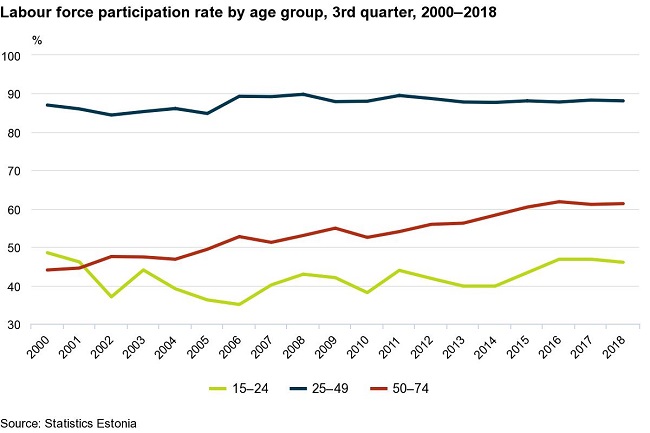Analytics, Demography, Estonia, Labour-market, Statistics
International Internet Magazine. Baltic States news & analytics
Friday, 19.04.2024, 22:51
Older persons are becoming more active in the labour market in Estonia
 Print version
Print versionThe labour market indicators did not change significantly compared to the same quarter of 2017. It is notable, however, that activity in the labour market among older persons, i.e. 50–74-year-olds, continues to grow. In the 3rd quarter, the employment rate of older persons reached 59.1%, which is the highest of the century. The labour market participation rate of older persons was 61.3% and their unemployment rate was 3.6%. Compared to the 3rd quarter of the previous year, the number of employed persons among age group 50–74 increased by 4,500 and the number of unemployed persons decreased by 3,000.
In the 3rd quarter of 2018, the indicators for 25–49-year-old persons, which is the most active group in the labour market, did not change significantly; their labour force participation rate was still high (88.1%).
The labour force participation rate of young people, i.e. 15–24-year-olds, was 46%. Although in recent years this figure has been stable, in the 3rd quarter of this year, the number of employed persons decreased and the number of unemployed persons increased in this age group.

In the 3rd quarter of 2018, compared to the same quarter of the previous year, the number of employed persons stayed the same at 666,600. At the same time, the number of employed persons working part-time has increased considerably. In the 3rd quarter of this year, the number of full-time workers was 588,000 and the number of part-time workers was 78,600. Comparing these figures to the 3rd quarter of 2017, the number of part-time workers has increased by 7,100 and the number of full-time workers has decreased as much. Young people and older persons are most likely to work part-time. In 2017, every fifth 15–24-year-old and every seventh 50–74-year-old worked part-time.
The number of inactive persons was 273,400 in the 3rd quarter. The biggest shares among inactive population were held by persons staying out of the labour market due to retirement (82,800), studies (63,300) and illness or disability (61,200).
Compared to the 3rd quarter of 2017, the number of persons inactive due to illness or disability increased by 4,000. The number of inactive persons due to studies decreased by 3,400. The reason could be that reconciliation between work and studying is easier for young people. The number of people inactive due retirement has decreased by 5,100, which is also illustrated by the increasing activity of 50–74-year-olds in the labour market.








 «The Baltic Course» Is Sold and Stays in Business!
«The Baltic Course» Is Sold and Stays in Business!

